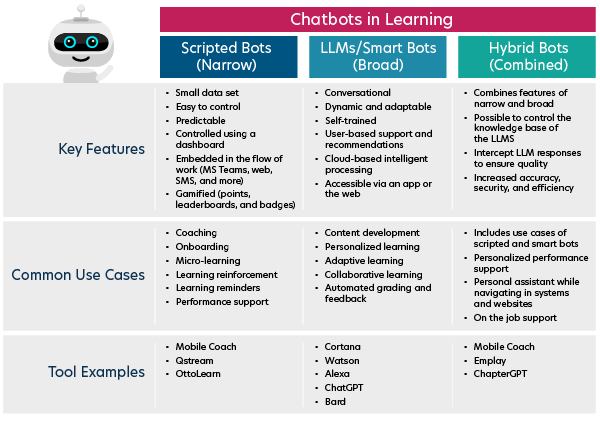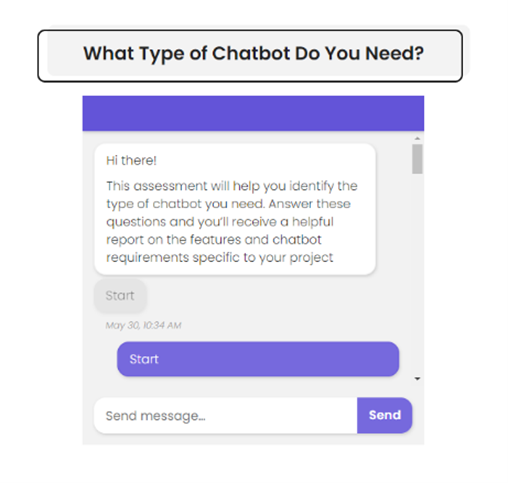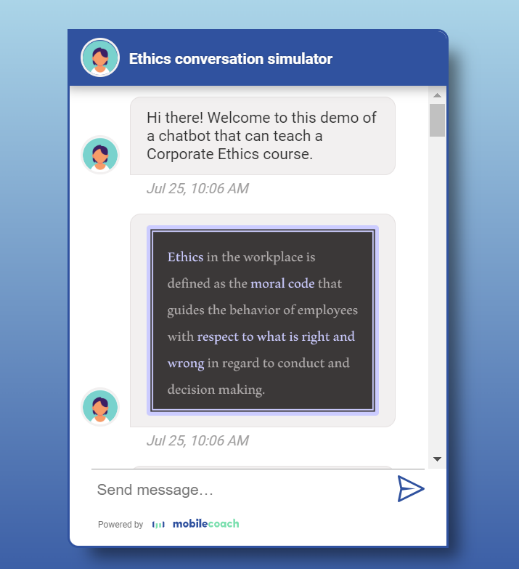Welcome to the world of chatbots and learning—and artificial intelligence (AI). Let’s explore the history of chatbots in relation to learning and development (L&D) processes and solutions and unpack the current uses of chatbots and how the evolution of generative AI impacts them.
The Evolution of Chatbots
A chatbot is a computer program designed to simulate conversation with human users, which is beneficial and relevant for today’s modern learners.
While the term chatbot was not used until the 1990s, the integration of chatbots with learning has been around for a while. Early forms of “chatbots” developed in the early 1950s were simple text-based programs that could only respond to a limited number of prompts. And people questioned whether a computer program could talk to a group of people without them realizing the speaker was artificial.
ELIZA is a well-known example of a primitive chatbot developed in 1966 by Joseph Weizenbaum at MIT. Although ELIZA was not explicitly intended for educational purposes, it showcased the potential of interactive conversational systems by responding to user inputs based on pattern matching.
Other examples, like PLATO, used machine learning to incorporate conversational elements into a machine that delivered instructional content. These early educational systems used scripted dialogues and question-and-answer interactions to guide learners through educational materials.
Fast forward to the twenty-first century, and the chatbot industry has evolved into sophisticated tools with learning applications that are seamlessly built into smartphones, such as Siri, Watson, Google Assistant, Alexa, and Cortana. With the development of natural language processing (NLP) technology, chatbots—like ChatGPT, Bard, and Bing—have become more interactive, adaptive, and personalized, and they can understand and respond to human language more naturally.
Types of Chatbots
We can categorize chatbots used for learning purposes into three key areas based on how they generate responses. Below are the key features, common use cases, and tool examples for the three key categories.

Scripted Chatbots
Scripted chatbots follow a predetermined set of rules within the boundaries of a scripted conversation. Some scripted chatbots allow you to create structured, personalized learning paths for the learner, and these chatbots don’t necessarily have to use high-powered AI. Scripted chatbots can be deployed in many channels like SMS text, MS Teams, and Web widgets to drive user engagement in the flow of work. They also provide integrated reporting and typically come with a dashboard that allows you to view analytics around the engagement and use of the chatbots as well as the users’ inputs. Scripted chatbots use a smaller data set, are easy to control, and are more predictable.
Try a Scripted Bot
This scripted chatbot developed by Mobile Coach helps you identify the desired critical attributes for the chatbot you need. Make sure to select START to begin. You need to answer about ten questions to get an assessment report with your requested chatbot features.

LLMs or Smartbots
LLMs (large language models) or smartbots fall under the category of generative AI because they use techniques such as natural language processing (NLP) and machine learning to understand and generate responses. These techniques allow for more dynamic and adaptable conversations and learning paths. The fact that responses are generative means that their output might not always be accurate and must be validated against other sources. The responses are also based on broad, publicly available content and are not specific to an enterprise’s context or knowledge base. However, LLMs are powerful tools for generating, adapting, and personalizing content based on the prompts provided by the user. LLMs are accessible via the web and through mobile apps.
Try a Smartbot
Add the following structured prompt in the LLM of your choice (ChatGPT, Bard, Bing, etc.) to get input on generating a scenario-based activity for a topic of your choice.
Act as an Instructional Designer. Create a scenario-based activity for <topic of your choice> in <context>. The scenario should be short, highly realistic, challenging for the learners, and well-structured
Hybrid Chatbots
Hybrid chatbots take the best of both worlds by combining elements of scripted and AI-powered chatbots to handle more complex queries or scenarios. This means they balance structure and adaptability in the learning process. Hybrid chatbots can also provide the possibility to control the knowledge base of the LLMs by connecting it to a company’s unique data and knowledge base and by monitoring the output of the conversation.
Try a Hybrid Bot
Here is an example of a hybrid chatbot with a ChatGPT-powered conversation simulator. This type of chatbot can be used in a microlearning course and delivered in the flow of work. Once you load the chatbot, please wait for it to give you some introductory information and present a scenario before you begin interacting with it.

Chatbots Are Powerful Learning Tools
While different types of chatbots have different strengths, some benefits make all chatbots powerful learning tools:
- On-demand, 24-hour availability
- Learning in the flow of work and at the point of need
- Increased learner engagement and motivation
- Intelligent learning personalization based on a learner’s profile and inputs
Choosing the Right Chatbot for Your Learners
AI is powerful, but it can’t solve every problem. It can be overwhelming to research and test the vast number of technologies and explore if they will help with your teams’ unique needs.
Some regulated industries, like the pharmaceutical industry, might prefer the greater control a scripted chatbot offers because they require all content to be pre-approved and regulated. If they used an AI-driven chatbot that dynamically creates content, there would be no way to guarantee what it would say. Other companies that use publicly available information to train their chatbot might prefer to go for a smart bot or a hybrid bot.
As you consider which type of chatbot is right for your learners, keep the following guidelines in mind.
- The best type of chatbot is the one that helps you address your business challenge effectively and provides relevant content for your learners.
- Whatever chatbot you choose, ensure it is used according to your organization’s guiding principles and in a safe, secure, and transparent way.
The future looks bright for chatbots and learning with the new generative AI tools. Subscribe to our AI Resource Center for deeper dives into AI and chatbots.
